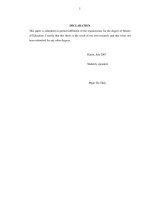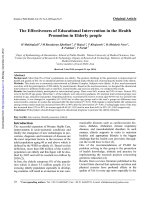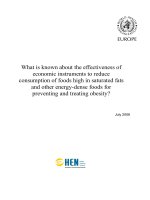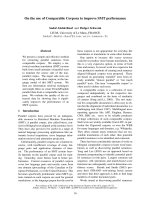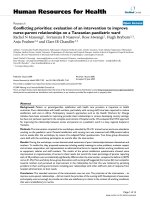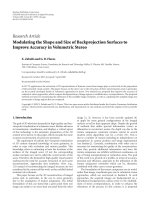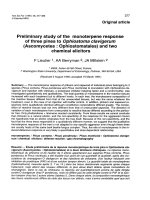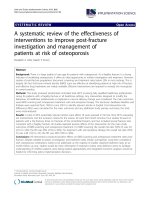Study the effectiveness of the intervention to improve the medical examination and treatment capacityof the commune health strations in the border areas of Tay Nguyen
Bạn đang xem bản rút gọn của tài liệu. Xem và tải ngay bản đầy đủ của tài liệu tại đây (147.91 KB, 8 trang )
Journal of military pharmaco-medicine no5-2018
STUDY THE EFFECTIVENESS OF THE INTERVENTION TO
IMPROVE THE MEDICAL EXAMINATION AND TREATMENT
CAPACITYOF THE COMMUNE HEALTH STRATIONS
IN THE BORDER AREAS OF TAY NGUYEN
Nguyen Minh Hung*; Trinh Thanh Hung*; Nguyen Van Bang*
Nguyen Van Ba** ; Nguyen Van Chuyen*** ; Le Bach Quang***
SUMMARY
Objectives: To evaluate the effectiveness of the intervention to improve the medical
examination and treatment capacity of the commune health stations in the border areas of the
Tay Nguyen. Subjects and methods: Intervention study with the commune health station and
240 households in Iapuch (intervention commune), the commune health station and 240
households in Iamo (control commune) from June 2015 to June 2016. Results: The average
number of patient visits of the intervention group increased from 0.73 to 0.92 visits per person
per year (an increase of 0.19 visits per person per year). Interventions effectiveness was
19.45%. The satisfaction of people on medical facilities at the commune health stations had
increased in the intervention group after intervention, this difference was statistically significant
(p < 0.05). The satisfaction of the people about waiting time before examination, procedures of
treatment, availability of medicines, medical examination fees, attitude of health staffs increased,
not statistically significant. Conclusions: Interventions improved the capacity of the commune
health stations effectively.
* Keywords: Commune health station; Intervention; Effectiveness; Border areas; Tay Nguyen.
INTRODUCTION
There are 28 communes of 12 districts
of 4 provinces (Kontum, Gialai, Daklak
and Daknong) in the border areas of Tay
Nguyen [1].The border line with Lao and
Cambodia is 530 km. This is the area with
the most difficult economic, social and
transportation conditions in Tay Nguyen.
Health care in the border areas of Tay
Nguyen is still heavily dependent on
grassroots health care, especially at
commune and village health levels. Therefore,
it is very necessary to research and develop
the solutions to improve the medical
examination and treatment capacity of
the commune health stations. Our aim is:
To evaluate the effectiveness of the
intervention to improve the medical
examination and treatment capacity of the
commune health stations in the border
areas of Tay Nguyen.
* Hochiminh University of Medicine and Pharmacy
**
***
Corresponding author: Nguyen Minh Hung ()
Date received: 08/03/2018
Date accepted: 23/05/2018
154
Journal of military pharmaco-medicine no5-2018
SUBJECTS AND METHODS
1. Subjects.
28 the commune health stations of 12
districts of 4 provinces (Kontum, Gialai,
Daklak and Daknong) in the border areas
of Tay Nguyen.
2. Methods.
* Study design:
Intervention study.
* Sample size and sampling:
- Sample size of household survey with
intervention group:
The sample size was estimated using
this following formula:
There in: n: Minimum intervention sample
size; p1: Estimated percentage of sick
people receiving medical treatment before
intervention.
According to the results of the research:
“Financial solutions in health care for rural
people in 04 districts in the Tay Nguyen
and Bacgiang in 2006” (PhD thesis in
public health of Nguyen Khanh Phuong),
the proportion of sick people receiving
medical treatment in the 4 weeks prior to
the survey is 58.6%.
p2: The hypothesis suggests that
interventions may increase the proportion
of sick people being treated, estimated at
73.6% (up to 15% compared to before
intervention) = (p1 + p2)/2.
Zα/2 = 1.96 (the value of the standard
deviation for the degree of reliability α = 5%).
Zβ = 0.84 (the value of the standard
distribution for the desired sample force
β = 80%).
Therefore, the number of people involved
in the intervention group is:
Thus, the minimum sample size to
conduct the intervention study is 155
people. On average, each household
selected one household head to conduct
interviews. Thus, the minimum sample
size to conduct research for each group
is 155 households, in fact we have
investigated 240 households.
- Sample size of household survey with
control group:
In the control commune, the number of
households surveyed was at least equal
to the number of households surveyed in
the commune. In fact, 240 households
have been surveyed.
- Sampling:
+ Select communes: Select intervention
commune: selectively, in 28 communes
were selected for descriptive study.
Select 01 commune that not only has
low rate of sick people receiving medical
examination and treatment but also has
not reached the national health standard
for the period of 2001 - 2010 and the
access of people to health services is
difficult. In fact, the intervention study was
carried out in the Iapuch commune of
Chuprong district, Gialai province.
Select the control commune: Select
the commune corresponding to the
intervention commune in terms of disease
incidence, health resources of the
commune health care, natural and social
conditions (Iapuch commune). During the
field survey, Iamo commune which
belonged to the same district of Chuprong,
155
Journal of military pharmaco-medicine no5-2018
Gialai province, met the requirements and
was selected for the control group.
+ Household selection: Make a list of
all households in the control and
intervention
commune.
Randomly
selected 240 households in the commune
intervention and 240 households in the
control commune to conduct pre and post
intervention survey.
* Exclusion criteria:
- Heads or respondents of households
refuse to participate.
- Persons who were sick within 4
weeks before the survey date.
* Perform intervention program:
- Intervention time: From June 2015 to
June 2016.
- The material facilities of commune
health stations:
+ The commune health stations
interventions is determined based on the
facilities and equipment regulations of the
National health standard in the period
2001 - 2010.
+ Investment contents include:
examination equipment, dentomaxillofacial
examination equipment, patient beds and
table balances.
Staff training intervention: collaborated
with Hospital 211, the 3rd Corps to organize
professional training courses for commune
health staffs.
+ To build medical and military clinics
(border medical ward and the commune
health station): support for commune
health care to improve the examination
and treatment ability.
- Communication skills:
Open 01 training course for communal
communication staff on communication skills.
Strengthening the communication through
loud speaker and radio of the village,
integrating into the village and commune
meetings to popularize people on methods
to prevent some common diseases.
* Evaluate results after intervention:
Results before and after the intervention
were compared in three dimensions:
- Survey and compare pre-intervention
group with control group.
Facilities intervention: repaired the house,
painted the wall.
- Survey and compare post-intervention
group with control group.
Equipment intervention: Provided medical
examination equipment, nose and throat
- Survey and compare pre-intervention
group with post-intervention group.
* Data processing methods:
Data were processed by computerized statistic using SPSS 18.0 software.
Interventions effectiveness is calculated using the following formula:
Efficiency index (%) =
x 100 (Intervention group)
(Before - after) index (%) =
x 100 (Control group)
X 1: Pre-intervention index.
X2: Post-intervention index.
Interventions effectiveness = (Efficiency index) - (Before - after index)
156
Journal of military pharmaco-medicine no5-2018
RESULTS
1. The effectiveness of interventions according to the average number of
people visiting the the commune health strations per year.
Table 1: The effectiveness of interventions according to the average number of
patient visits.
Pre-intervention
Post-intervention
(visits per person per year)
(visits per person per year)
Intervention
0.73
0.92
26.03
Control
0.61
0.65
6.58
Groups
Efficiency index (%)
Intervention effectiveness (%)
19.45
The table shows that the average number of patient visits of the control group was
almost unchanged. In contrast, the average number of patient visits of the intervention
group increased from 0.73 to 0.92 visits per person per year (increased 0.19 visits per
person per year). Interventions effectiveness was 19.45%.
2. Effectiveness of intervention on facilities and equipment at the commune
health station.
Table 2: Effectiveness of intervention on facilities and equipment at the commune
health stations.
Facilities and equipment at the commune
health stations
Pre-intervention
Post-intervention
Iapuch
Iamo
Iapuch
Iamo
Media room
-
-
-
-
Reception room
-
-
+
-
Drugstores
-
-
+
-
Examination room
+
+
+
+
Family planning services
+
+
+
+
Delivery room
+
+
+
+
Postpartum care room
-
-
+
-
Treatment room
+
+
+
+
Pasteurize room
-
-
+
-
Traditional medicine clinic
-
-
+
-
Dear-nose-throat (ENT) and eye clinics
-
-
+
-
Consulting room
-
-
+
+
The clinic's rooms
157
Journal of military pharmaco-medicine no5-2018
Traditional medicine garden
Traditional medicine garden
+
+
Traditional medicine garden with 20 - 40 plants
+
+
+
+
+
Traditional medicine garden with more than 40
plants
+
Health education materials
Enough
+
Not enough
+
+
+
The commune health station (Iapuk commune of Chuprong district, Gialai province)
has its own consulting room, ENT and eye clinics, traditional medicine clinic after
intervention.
The traditional medicine garden has been supplemented with medicinal plants to
ensure that the garden has 40 or more medicinal plants. The commune health station
has also provided enough health education materials for community. The infrastructure
of control the commune health station after 1 year intervention unchanged.
3. The effectiveness of interventions at the households.
Table 3: The initial management of patients.
Control group
Initial management of patients
Intervention group
Pre-intervention Post-intervention
(n = 86)
(n = 114)
Pre- intervention
(n = 104)
Postintervention
(n = 108)
n
%
n
%
n
%
n
%
No treatment
6
6.98
4
3.51
17
16.35
5
4.63
Buy drugs at the drug stores
33
38.37
29
25.44
34
32.69
7
6.48
Take available medicine at home
15
17.44
12
10.53
18
17.31
8
7.41
Visit the village health
6
6.98
12
10.53
3
2.88
8
7.41
Visit the commune health station
13
15.12
36
31.58
20
19.23
54
50.0
Visit the regional clinic
1
1.16
1
0.88
0
0.0
1
0.93
Visit the district hospital
5
5.81
2
1.75
4
3.85
3
2.78
Visit the provincial hospital
1
1.16
0
0.0
1
0.96
3
2.78
Visit the central hospital
2
2.33
2
1.75
0
0.0
2
1.85
Visit the private health facilities
1
1.16
13
11.40
6
5.77
10
9.26
Visit traditional medicine physician
3
3.49
1
0.88
0
0.0
1
0.93
Invite doctors to the house
0
0.0
2
1.75
1
0.96
4
3.70
Others
0
0.0
0
0.0
0
0.0
2
1.85
It can be seen in the table that the percentage of visiting the commune health station
in the intervention group increased from 19.23% to 50.00%. The percentage of buying
158
Journal of military pharmaco-medicine no5-2018
drugs at the drug stores and take available medicine at home decreased from 32.69%
to 6.48% in the intervention group, from 38.37% to 25.44% in the control group.
Table 4: Evaluation of the intervention’s effectiveness increasing the use of public
health services among residents.
Group
Pre-intervention (%)
Post-intervention (%)
Efficiency index (%)
Intervention
29.81
67.60
126.77
Control
26.74
47.36
77,11
Intervention effectiveness (%)
49.66
The percentage of using public health services increased in the intervention group
(37.79%) and the control group (20.62%). Interventions effectiveness was 49.66%.
This difference was statistically significant (p < 0.05).
4. The effectiveness of interventions on the people's satisfaction.
Table 5: The effectiveness of interventions on the people's satisfaction.
Pre-intervention
(%)
Post-intervention
(%)
Efficiency index
(%)
Intervention
50.42
83.75
66.15
Control
47.92
57.92
20.87
Group
Waiting time
before
examination was
reasonable
Procedures of
treatment
Interventions effectiveness (%)
45.28
Intervention
44.58
82.92
86.00
Control
42.50
52.08
22.54
63.46
Interventions effectiveness (%)
Equipment
Intervention
35.83
42.50
18.62
Control
34.17
30.83
-9.78
28.40
Interventions effectiveness (%)
Availability of
medicines
Intervention
39.58
47.92
21.07
Control
38.75
43.33
11.82
9.25
Interventions effectiveness (%)
Attitudes of health
staffs
Intervention
46.67
95.42
104.46
Control
39.17
46.25
18.08
86.38
Interventions effectiveness (%)
Medical
examination fees
Intervention
35.42
72.08
103.50
Control
31.67
38.75
22.36
Interventions effectiveness (%)
81.14
This table shows that the satisfaction of people on medical facilities at the commune
health stations had increased in the intervention group after intervention, this difference
159
Journal of military pharmaco-medicine no5-2018
was statistically significant (p < 0.05). The satisfaction of the people about waiting time
before examination, procedures of examination, availability of medicines, medical
examination fees, attitude of health staffs had increased, not statistically significant.
DISCUSSION
- Advanced facilities: To improve the
quality of medical examination and treatment,
in addition to improving the professional
level for medical staff, the improvement of
facilities is very important. Facilities and
attitudes of health staffs have improved
significantly. Therefore, people are more
confident in the commune health strations.
The quality of treatment has been improved
in the intervention group. The commune
health station (Iapuk commune of Chuprong
district, Gialai province) has its own
consulting room, ENT and eye clinics,
traditional medicine clinic, traditional
medicine garden with more than 40 plants,
provided enough health station after
intervention. Thus, compared to the
control group, facilities of intervention the
commune health strations has increased
significantly and reached the commune
health standards by 2010 [2]. This is one
of the important factors to improve the
quality of Iapuch the commune health
stration. The view of investment in facilities
is also in line with Nguyen Kim Chau
(1996) [3].
- Improve communication efficiency:
Communication and health education at
the intervented the commune health station
is particularly noticed both of the speaker
and the consulting room. Intervention the
commune health stations has consulting
room.
160
All of these interventions are aimed at
improving the quality of health services
and are valued through customer satisfaction.
Results of our study showed that in the
intervention group, the proportion of
satisfied patients with waiting time
increased from 50.42% to 83.75%
(interventions effectiveness: 45.28%), the
proportion of the satisfied patients with
the procedure of treatment increased
from 44.58% to 82.92% (intervention
effectiveness: 63.46%), the proportion
of satisfied patients with equipment
increased from 35.83% to 42.50%
(intervention effectiveness: 28.40%) and
the proportion of satisfied patients with
the attitudes of health staffs increased
from 46.67% to 95.42% (intervention
effectiveness: 86.38%).
Our research shows that the effectiveness
of interventions on the use of services at
health stations is quite good. In the
control group, the average number of
visits before and after the intervention
was almost unchanged (0.61 vs. 0.65
visits per person per year). In contrast, in
the intervention group, the average
number of visits before and after the
intervention increased significantly (from
0.73 to 0.92 visits per person per year).
Intervention effectiveness was 19.45%.
The rates of visits to public health
facilities (the commune health stations,
district hospitals, provincial and central
hospitals) in both intervention and control
Journal of military pharmaco-medicine no5-2018
groups increased (29.81% and 26.74%
before intervention, 67.60% and 47.36%
after intervention). The percentage of
using public health services increased in
the intervention group (37.79%) and the
control group (20.62%). Intervention
effectiveness was 49.66%. This difference
was statistically significant (p < 0.05).
The National Health Survey 2001 - 2002
also showed that the number of visiting
the commune health stations which were
equipped with standard medical instrument
(stethoscope, temperature measurement,
blood pressure measurement), reproductive
health examination instrument (adult weight
scale, birth table, family planning tools,
gynecological examination instrument,
fetal stethoscopes, pelvic measurements,
pregnancy stick tests), specialist
examination instrument (instrument for
eye, ear, nose and throat examination)
was higher than other communes [4]. The
number of visits to communes which
having enough equipments for medical
examination is higher than other
communes. This is the effectiveness of
our interventions at the commune health
stations. It demonstrates the effectiveness
of our intervention based on evidence of
use of treatment services by people in the
intervention communes. It has also been
studied by a number of foreign authors [5].
CONCLUSION
Intervention improved the examination
and treatment capacity of the commune
health stations effectively.
This article’s data dues to the state level
research “Research on the intervention
increasing the ability to protect the public
health in the national frontier in Tay Nguyen
and to create goods from the local herbs.
Code: TN16/T03”.
REFERENCES
1. General Statistics Office of Vietnam.
Geographical map of provinces and cities of
Vietnam. Vietnam Education Publishing House.
2018.
2. Vietnam Ministry of Health. Determination
370/2002/QĐ-BYT about promulgation of
“National standard on medical communes in
the 2001 - 2010 period. 2002.
3. Nguyen Kim Chau. Study on the
morbidity and mortality of patients treated at
Hospital V of Military Region V for 5 years
(1991 - 1995) and major organizational
measures to improve the quality of treatment.
Specialized thesis II. 1996.
4. Vietnam Ministry of Health. Report the
results of the national health survey 2001 2002. 2003.
5. Andersen R, Aday L.A. A Framework for
the study of access to medical care. 1974,
pp.208-220.
161

